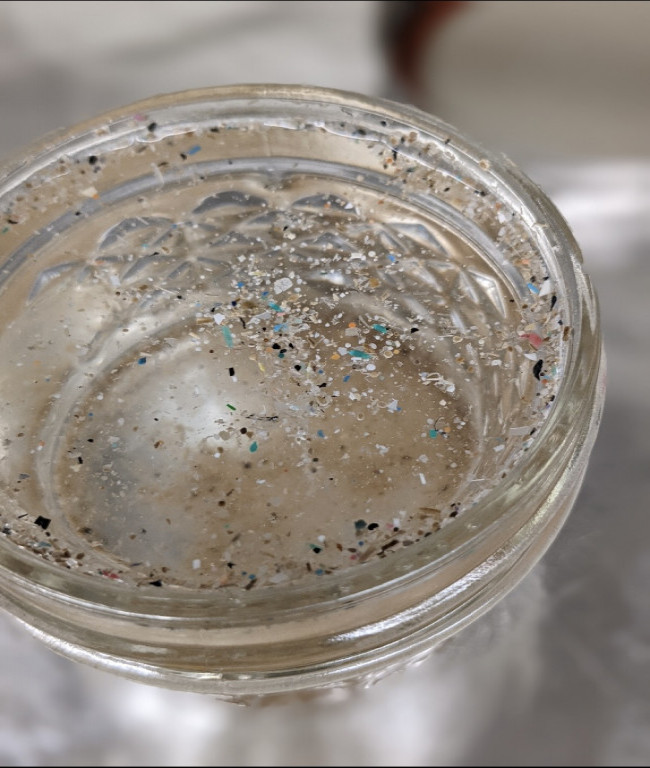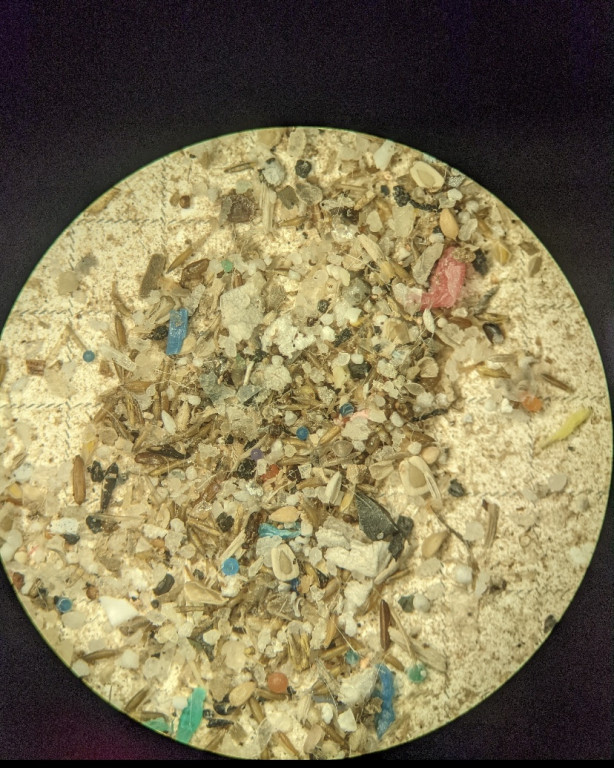
Photo of a collection of microplastic pieces floating in a glass of water. (Courtesy of Laura Markley)

Photo of a collection of microplastic pieces floating in a glass of water. (Courtesy of Laura Markley)
Plastic is a well-known threat to the environment, but what many people may not know, is that it is also a threat to our organs. According to The National Oceanic and Atmospheric Administration (NOAA), there is a growing army of tiny plastic pieces of waste known as microplastics, that are traveling around the world. This global environmental issue was first recognized by scientists in the 1970s but has gained even more attention in recent decades.
This is a multifaceted problem, as the Environmental Protection Agency (EPA), states that these tiny particles come with a variety of characteristics including size, composition, and are of different densities within our environment. This invasion of microplastics doesn’t just damage the quality of our oceans, it festers and grows in the air we breathe, our food and drinks, and the products we use. It is so pervasive that, according to Science Direct, a recent study showed that this army of microplastics has marched its way into people’s bodies, including our bloodstreams.
The result of this study showed that 80% (17 out of 22) of the study’s subjects contained these life-threatening particles in their bloodstreams, which suggests that microplastics are in fact commonplace in most people’s bodies. The damage is outlined in another study from Rovira University, which states that microplastics can stretch the membranes of red blood cells to the point where the transportation of oxygen in our circulatory system is affected.
Some people may never consider where the objects in the recycling bins actually end up or if those objects are actually being recycled. According to Upstream Solutions, only 6% of plastics are recycled and more than one-third of plastic packaging finds its way into the environment. When plastics are left alone in the ocean or on land, they break down into microplastics that can be smaller than five millimeters, resembling the size of a sesame seed. The United Nations Clean Seas Campaign found that there are approximately 51 trillion microplastic pieces in the ocean alone.
A handful of these particles may seem harmless, but since they are hydrophobic, meaning of a substance that repels water, an accumulation of them can cover many surfaces and absorb various organic pollutants including pesticides and industrial chemicals. According to the National Library of Medicine, once these harmful chemicals are ingested by organisms, they can easily accumulate in their systems and threaten their gastrointestinal tract. These particles are often transferred from one organism to another through ingestion, and have been able to reach humans. This common process is known as trophic transfer.
“I would assume living in a place where you’re around a lot of people, you’d probably increase your exposure (to microplastics),” said Laura Markley, a Ph.D. candidate studying plastic pollution at Syracuse University. “I think it would really depend on where you live.”
Living in a populated city like Syracuse, New York, it’s no surprise that most of the residents produce plastic waste. In today’s world, plastic is an ubiquitous staple of grocery shopping that consumers of all ages have a hard time avoiding. “It’s very difficult for an individual to reduce their production when the system is kind of made to produce that way,” Markley said.

Shopping bags are not the only significant way that we come into contact with plastics. When we store our leftovers from previous meals or have a craving for the remainder of our takeout, the most convenient way of storing and reheating our food is by microwaving it in plastic containers.
According to Markley, there are many processing agents and chemicals that give plastics desirable characteristics, but when those plastics are exposed to certain conditions such as high temperatures, as significant amount of those harmful chemicals within the plastic can leach out into the food we consume. One way this problem occurs is by using the same plastic container over and over again which eventually leads to parts of the plastic shedding off into the food we look forward to eating.
Markley also emphasized that leached chemicals can mimic estrogen, the hormone key to the female reproductive system. According to Breastcancer.org, Bisphenol-As (BPA) is an industrial chemical commonly found in plastics such as water bottles and sold in stores, that mimics estrogen which can lead to various kinds of cancer in women. Markley went on to say, “That was just crazy to me because I was like, how can something I’ve used my entire life, be the source of these toxic chemicals!”
I also spoke with Marcus Eriksen, Ph.D., scientist and co-founder of the 5 Gyres organization, who emphasized how recycling contributes to plastic pollution. Eriksen mentioned how many of us have been fooled into believing that participating more in this process will solve this world crisis. In reality, more needs to be done than just tossing single-use plastics into the recycling bin.
Many materials such as plastic utensils and take-out containers are placed in landfills or end up in our oceans because they can not be recycled.
In our interview, Eriksen said that cleaning up a patch of trash in the ocean and on land will not fix the entire problem. Rather, it will take strategies to address the source of the issue, such as creating better designs for products and implementing source reduction without plastic.
At the individual level, we certainly can aim to reduce our use of plastics. But the microplastics issue also needs to be addressed at a higher, larger level – through laws and policies. Organizations similar to 5 Gyres collaborate with policymakers to form agreements that hold companies accountable for their plastic production and aim to reduce the consumption of plastic. This ongoing world crisis can only be improved by working at its source to truly see a positive difference in our future.
Our government has the choice of acting on this worldwide issue, we just have to push our politicians. This task is easier said than done. But if we, as individuals, begin to hold our own usage of plastics accountable and communicate the dangers of microplastics to our representatives, there is hope that broader change is yet to come.